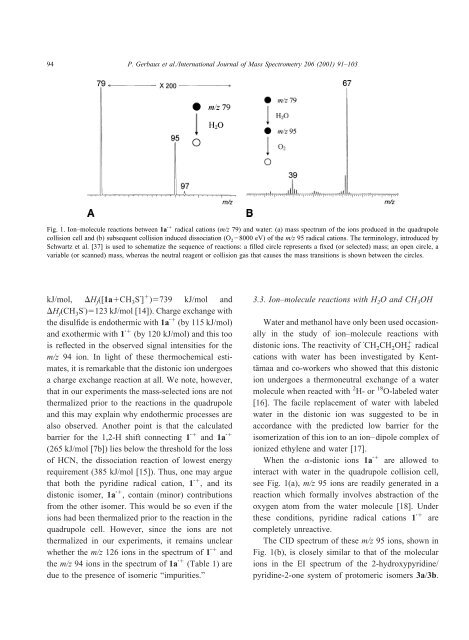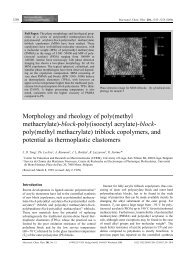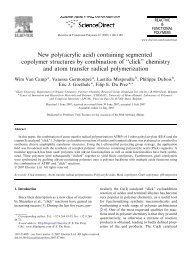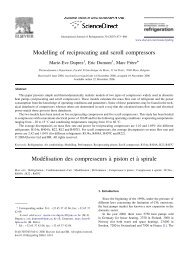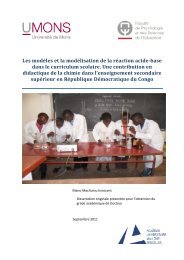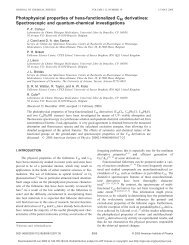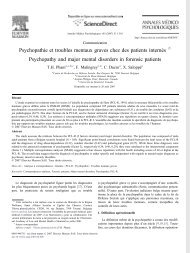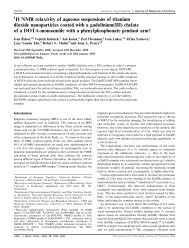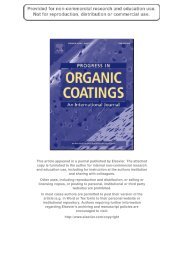Definitive characterization of some C5H5N and C radical cations by ...
Definitive characterization of some C5H5N and C radical cations by ...
Definitive characterization of some C5H5N and C radical cations by ...
You also want an ePaper? Increase the reach of your titles
YUMPU automatically turns print PDFs into web optimized ePapers that Google loves.
94 P. Gerbaux et al./International Journal <strong>of</strong> Mass Spectrometry 206 (2001) 91–103<br />
Fig. 1. Ion–molecule reactions between 1a <strong>radical</strong> <strong>cations</strong> (m/z 79) <strong>and</strong> water: (a) mass spectrum <strong>of</strong> the ions produced in the quadrupole<br />
collision cell <strong>and</strong> (b) subsequent collision induced dissociation (O 2 8000 eV) <strong>of</strong> the m/z 95 <strong>radical</strong> <strong>cations</strong>. The terminology, introduced <strong>by</strong><br />
Schwartz et al. [37] is used to schematize the sequence <strong>of</strong> reactions: a filled circle represents a fixed (or selected) mass; an open circle, a<br />
variable (or scanned) mass, whereas the neutral reagent or collision gas that causes the mass transitions is shown between the circles.<br />
kJ/mol, H f ([1aCH 3 S ] )739 kJ/mol <strong>and</strong><br />
H f (CH 3 S )123 kJ/mol [14]). Charge exchange with<br />
the disulfide is endothermic with 1a (<strong>by</strong> 115 kJ/mol)<br />
<strong>and</strong> exothermic with 1 (<strong>by</strong> 120 kJ/mol) <strong>and</strong> this too<br />
is reflected in the observed signal intensities for the<br />
m/z 94 ion. In light <strong>of</strong> these thermochemical estimates,<br />
it is remarkable that the distonic ion undergoes<br />
a charge exchange reaction at all. We note, however,<br />
that in our experiments the mass-selected ions are not<br />
thermalized prior to the reactions in the quadrupole<br />
<strong>and</strong> this may explain why endothermic processes are<br />
also observed. Another point is that the calculated<br />
barrier for the 1,2-H shift connecting 1 <strong>and</strong> 1a <br />
(265 kJ/mol [7b]) lies below the threshold for the loss<br />
<strong>of</strong> HCN, the dissociation reaction <strong>of</strong> lowest energy<br />
requirement (385 kJ/mol [15]). Thus, one may argue<br />
that both the pyridine <strong>radical</strong> cation, 1 , <strong>and</strong> its<br />
distonic i<strong>some</strong>r, 1a , contain (minor) contributions<br />
from the other i<strong>some</strong>r. This would be so even if the<br />
ions had been thermalized prior to the reaction in the<br />
quadrupole cell. However, since the ions are not<br />
thermalized in our experiments, it remains unclear<br />
whether the m/z 126 ions in the spectrum <strong>of</strong> 1 <strong>and</strong><br />
the m/z 94 ions in the spectrum <strong>of</strong> 1a (Table 1) are<br />
due to the presence <strong>of</strong> i<strong>some</strong>ric “impurities.”<br />
3.3. Ion–molecule reactions with H 2 O <strong>and</strong> CH 3 OH<br />
Water <strong>and</strong> methanol have only been used occasionally<br />
in the study <strong>of</strong> ion–molecule reactions with<br />
distonic ions. The reactivity <strong>of</strong> CH 2 CH 2 OH 2 <strong>radical</strong><br />
<strong>cations</strong> with water has been investigated <strong>by</strong> Kenttämaa<br />
<strong>and</strong> co-workers who showed that this distonic<br />
ion undergoes a thermoneutral exchange <strong>of</strong> a water<br />
molecule when reacted with 2 H- or 18 O-labeled water<br />
[16]. The facile replacement <strong>of</strong> water with labeled<br />
water in the distonic ion was suggested to be in<br />
accordance with the predicted low barrier for the<br />
i<strong>some</strong>rization <strong>of</strong> this ion to an ion–dipole complex <strong>of</strong><br />
ionized ethylene <strong>and</strong> water [17].<br />
When the -distonic ions 1a are allowed to<br />
interact with water in the quadrupole collision cell,<br />
see Fig. 1(a), m/z 95 ions are readily generated in a<br />
reaction which formally involves abstraction <strong>of</strong> the<br />
oxygen atom from the water molecule [18]. Under<br />
these conditions, pyridine <strong>radical</strong> <strong>cations</strong> 1 are<br />
completely unreactive.<br />
The CID spectrum <strong>of</strong> these m/z 95 ions, shown in<br />
Fig. 1(b), is closely similar to that <strong>of</strong> the molecular<br />
ions in the EI spectrum <strong>of</strong> the 2-hydroxypyridine/<br />
pyridine-2-one system <strong>of</strong> protomeric i<strong>some</strong>rs 3a/3b.


